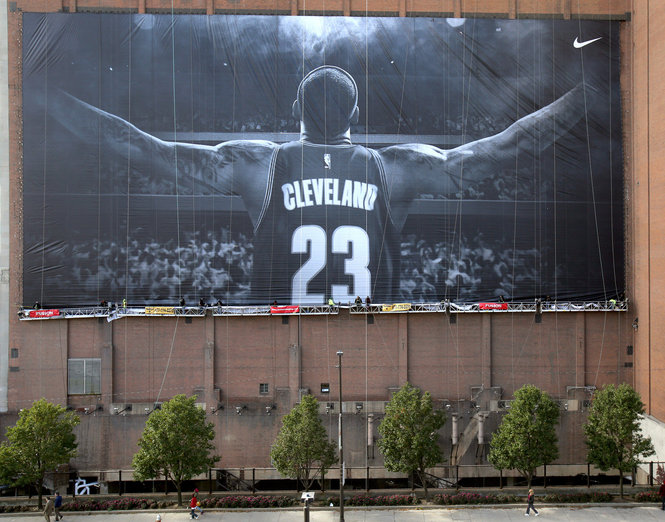The New York Times on the economic and financial impact of local hero LeBron James’ return to Cleveland and NE Ohio:
When LeBron James announced his return to the Cleveland Cavaliers in July, fans celebrated by hanging banners, getting drunk and digging old jerseys out of purgatory. They ran into the streets, honked horns and hugged strangers. And some of them started trying to figure out just how much money was about to rain down on Cleveland. According to one estimate, the return of the “king,” as James is known, will add $500 million a year to the city’s economy. “When people say this is just about an athlete making money, there’s more to it than that,” said Edward FitzGerald, the Cuyahoga County executive, at a news conference devoted to the anticipated windfall. “Other people will make a living.”
James is certainly a good investment for the Cavaliers, who will probably cover his $20.6 million salary just from increased ticket sales. The last season James played in Cleveland, after all, the Cavs sold every available regular-season seat at an average price of $55.95, earning about $47 million. Last season, the Cavaliers sold just 84 percent at an average price of just $43.31, for a decline of $16 million. This year, season tickets sold out the day James announced his return, and demand is so overwhelming that the team is raffling the remaining single-game tickets so that everyone in Cleveland has a fair chance. Everything else is gravy: playoff games, sponsorships, jersey sales and the team’s local broadcast rights, serendipitously scheduled for renegotiation at the end of next season.
What FitzGerald and some other Cleveland boosters envision, though, is a LeBron stimulus that enriches the city as a whole. Start, for example, with the restaurants along East Fourth Street, near the arena, whose business dropped significantly after James bolted for Miami. Scalpers are happy, too, and owners of nearby stores that sell T-shirts and jewelry also expect sales to pick up. To get that $500 million estimate, LeRoy Brooks, an emeritus professor of finance at John Carroll University, just outside Cleveland, assumed that all these people making more money will spend it in Cleveland, multiplying the James effect. Brooks told me he now thinks James will add between $163 million and $426 million to the regional economy. He said that he made the first estimate in haste, “on the day after my first grandson was born.” FitzGerald’s staff estimated a more modest bounce. The LeBron stimulus, they concluded, could reach $285 million, including the creation of about 550 new jobs.
Certain individuals have changed a city’s fortunes. John D. Rockefeller helped to drive Cleveland’s rise as an industrial power. Bill Gates sparked Seattle’s high-tech transformation. Dan Gilbert, the founder of Quicken Loans and owner of the Cavs, has purchased a large chunk of downtown Detroit, which he is slowly renovating and repopulating.
But James is not an entrepreneur: He’s a wage-earning entertainer who manufactures jump shots and no-look passes. And there is a limit to how much difference one more union member can make. Last year, the Cleveland area’s economic output was about $123 billion. By the most generous estimates, the return of James would expand output by less than one half of 1 percent. The biggest economic engine in postindustrial Cleveland is probably the Cleveland Clinic, a sprawling treatment and research center that estimates its own annual impact at about $10.5 billion, or 8 percent of the regional total. So the best case is that the return of James has about the same effect as a modest hospital expansion.
Moreover, other experts regard these estimates as wildly inflated. Victor Matheson, an economist at the College of the Holy Cross in Massachusetts, calls it “the worst economic-impact estimate ever,” because most of the projected spending is just dollars sloshing around northeast Ohio. What’s good for downtown Cleveland, in other words, is bad for the suburbs. “It’s just going to result in a redistribution of entertainment spending from other activities to the Cavs,” said Edward W. Hill, dean of the Levin College of Urban Affairs at Cleveland State University.
“My wife is now beating me on top of the head to make sure that I get our tickets, which will mean one less dinner together at a restaurant as we go to the Cavs instead.” It’s also worth noting that Cleveland is paying for the right to host James. Cuyahoga County borrowed $120 million in the early 1990s to build the team’s arena, and it still owes more than half that sum. Earlier this year, voters approved extending a tax that is projected to raise $260 million for the city’s three stadiums. Any benefits of James’s return are, in effect, a return on that investment.
But Hill does see a more intangible benefit. Nike paid James roughly $13 million a year to endorse its products during his first stint in Cleveland. He has since signed a new deal that is said to be even more lucrative. Now James is effectively endorsing Cleveland too. People looking for basketball shoes may be more likely to value his endorsement than people looking for a place to live or to locate their businesses, but every little bit helps. “We’ve had the best public relations for Cleveland since World War II,” FitzGerald told a local radio station a few days after James announced his return. On a recent trip to Guangzhou, China, Hill said he saw a man in a park, dressed in a James jersey with “Cleveland” emblazoned across the front. “For a midsize metropolitan area, the fact that you are affiliated with a global brand gives you name recognition that cuts across the clutter,” he said.
The return of James, which was announced just a week after the news that the 2016 Republican National Convention will take place in Cleveland, could also change the way residents think about their city. And economically speaking, mood matters. John Maynard Keynes regarded “animal spirits” as a primary motor of growth. When people are feeling good, they are more likely to take risks and make investments. Officials hope the excitement will stoke continued residential development in the gaptoothed downtown, where the population has roughly doubled since 2000. “I want kids in Northeast Ohio . . . to realize that there’s no better place to grow up,” James wrote when announcing his decision in Sports Illustrated. “Maybe some of them will come home after college and start a family or open a business.”
Cleveland, in some sense, is hoping to follow the paradigm of Manchester, England, another downtrodden factory town that is now best known for its soccer teams. Manchester United sells 30 percent of its tickets to people from outside the region and, seeking to capitalize on the tourism, the city opened a national soccer museum in 2012. The region’s economic-development brochures often feature an image of Old Trafford, United’s stadium, and economic-development officials sometimes follow the team on road trips. This kind of glamour by association is an easy way to start a conversation, although a recent economic study of the city cautioned that it can only take that conversation so far. “Whenever it comes down to the actual completion of a deal, it is the competitiveness of the offering that matters,” it said.
But there’s an important difference between hosting the world’s most famous soccer team and the world’s most famous basketball player. Franchises stick around, but kings do not rule forever. Cleveland has just a few years to capitalize.

